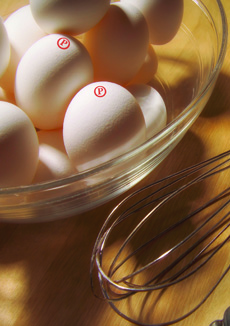Cookie Dough For Dessert & How To Pasteurize Raw Eggs
|
|
Eating raw cookie dough is no doubt as old as baking cookies. It’s different than, but equally as delicious, as the baked cookies. We know: Every time we make a batch of chocolate chip cookie dough, we end up with just 2/3 of the yield, and the rest of the raw dough nibbled away during prep. Sometimes we mix up a batch just for the dough. You can wrap individual portions of dough and freeze them for future snacking. In fact, make a few different flavors at your leisure, shape them into individual balls, and freeze them, and you’ll have an “instant” chocolate cookie dough dessert. You can wrap individual balls, or place them in ice cube trays. Edoughble, a company that sells raw, ready-to-eat cookie dough (second photo), makes a selection of flavors: birthday cake, chocolate chip, chocolate peanut butter, cookies and cream, oatmeal chip, peanut butter banana chip, red velvet, s’mores, snickerdoodle, and seasonal flavors (it’s orange creamsicle this summer). You can serve it on spoons, as in the photo; in a sundae dish with fresh fruit; with a side of graham crackers; or as a mini banana split. Make your own cookie dough ice cream. Just roll small balls of cookie dough and blend them into a softened pint of vanilla ice cream. It doesn’t have to be chocolate chip cookie dough. Oatmeal cookie or sugar cookie dough works just fine. Chocolate chip cookie dough was created by accident by Ruth Wakefield, an inn owner on Cape Cod, in 1937. It took almost 50 years for it to become a favorite ingredient in ice cream. Phil’s flavor was followed by one from the far-better-known Ben & Jerry’s in Burlington, Vermont, which got the idea from a customer suggestion (perhaps a customer of Fabulous Phil’s?). B&J bought cookie dough from a distributor, working with the company to make dough with the right consistency for a mix-in (known in the trade as an inclusion). After the deadliest* Salmonella outbreak in history in 1985 traced to a dairy in the Midwest, the U.S. Food and Drug Administration (FDA) strongly discouraged consumption of it in everything from Caesar Salad to Steak Tartare and other popular recipes†. Many companies reformulated recipes to eliminate raw eggs or use pasteurized raw eggs, in which the bacteria have been eliminated. First, a disclaimer: If you have a health condition or general concern*, consult with your physician before eating anything raw. The easy way to make safer cookie dough is to buy commercially pasteurized eggs. Look for Davidson’s Safe Eggs, pasteurized raw eggs. You can tell they’re pasteurized from the red “P” stamped onto each egg. If your grocer does not carry them, ask the manager to bring them in. Learn more at SafeEggs.com. Pasteurized eggs undergo an all-natural pasteurization process that kills harmful bacteria without altering the consistency or texture of the eggs. They look and act just like raw eggs while eliminating the risk of salmonella. Unlike processed liquid eggs, they deliver the fresh flavor delivered by raw eggs. So you can enjoy the brownie batter, cookie dough, and other raw egg foods† with the gusto they deserve. |
|
|
RECIPE: HOW TO PASTEURIZE RAW EGGS Home pasteurization doesn’t provide the 100% guarantee that commercially pasteurized eggs do, but it will significantly reduce any risk. (Also note that, as with many products, other ingredients can be contaminated including flour and nuts.) Preparation 1. HEAT a pot of water over medium heat to 145°F. Monitor the temperature with a probe thermometer. 2. PLACE fresh, room-temperature eggs in the pot; the water must completely cover the eggs. Lower the heat and maintain the 145°F temperature. Do not let the temperature reach 160°F or you’ll start to cook the eggs. 3. REMOVE the eggs after 3-1/2 minutes, or 5 minutes for extra-large and jumbo eggs. Then use or refrigerate. They’ll stay even fresher because the bacteria have been killed off. *Salmonella generates more illnesses than fatalities but can be fatal for risk groups, such as young children, the elderly and infirm. Here’s more from Web M.D. †Brownie/bar and cake batter, Caesar salad, cookie dough, cold/frozen soufflés, chiffons, French custard ice cream, eggnog, egg smoothies, egg white cocktails, homemade mayonnaise, mousse, steak tartare and others. CHECK OUT WHAT’S HAPPENING ON OUR HOME PAGE, THENIBBLE.COM. |
||






